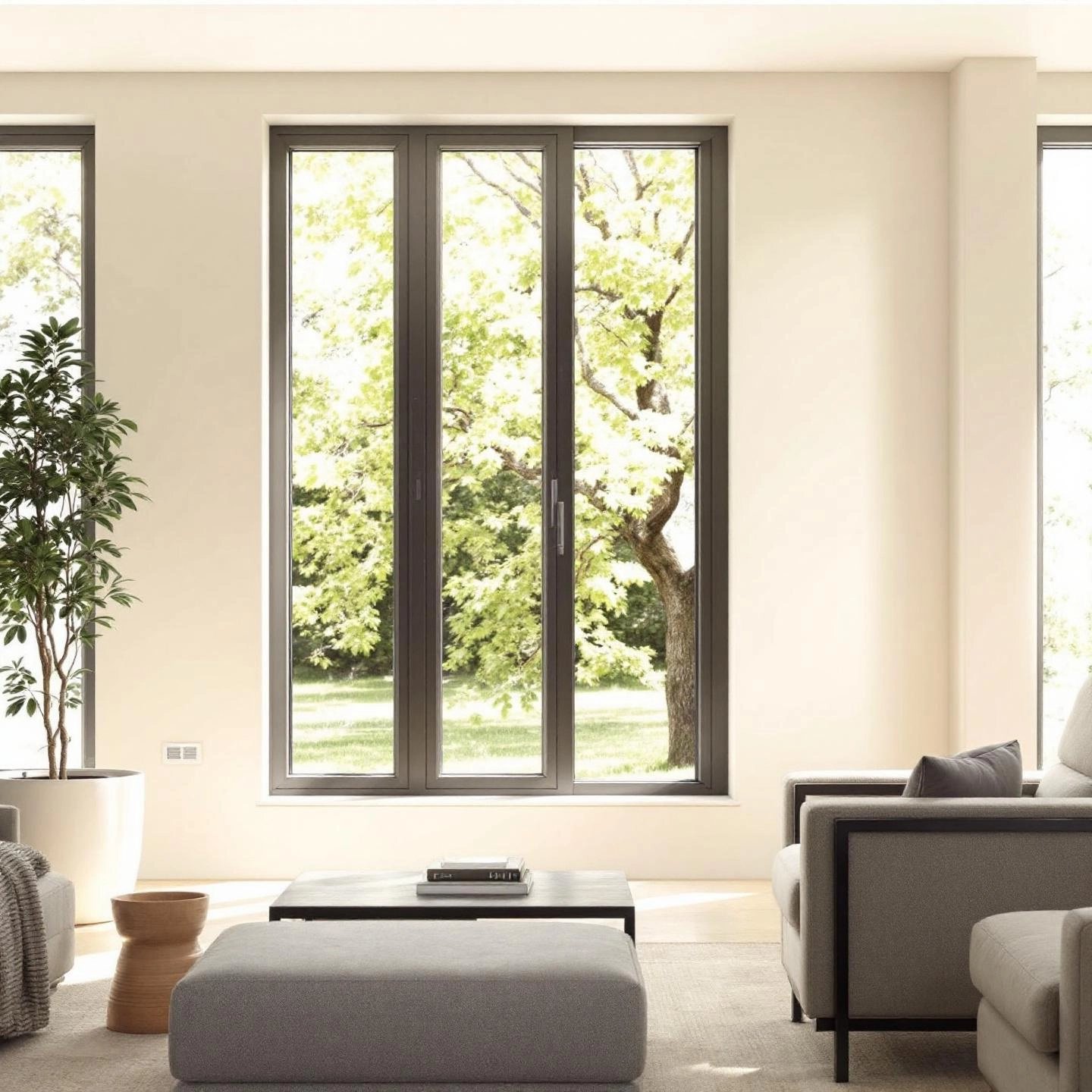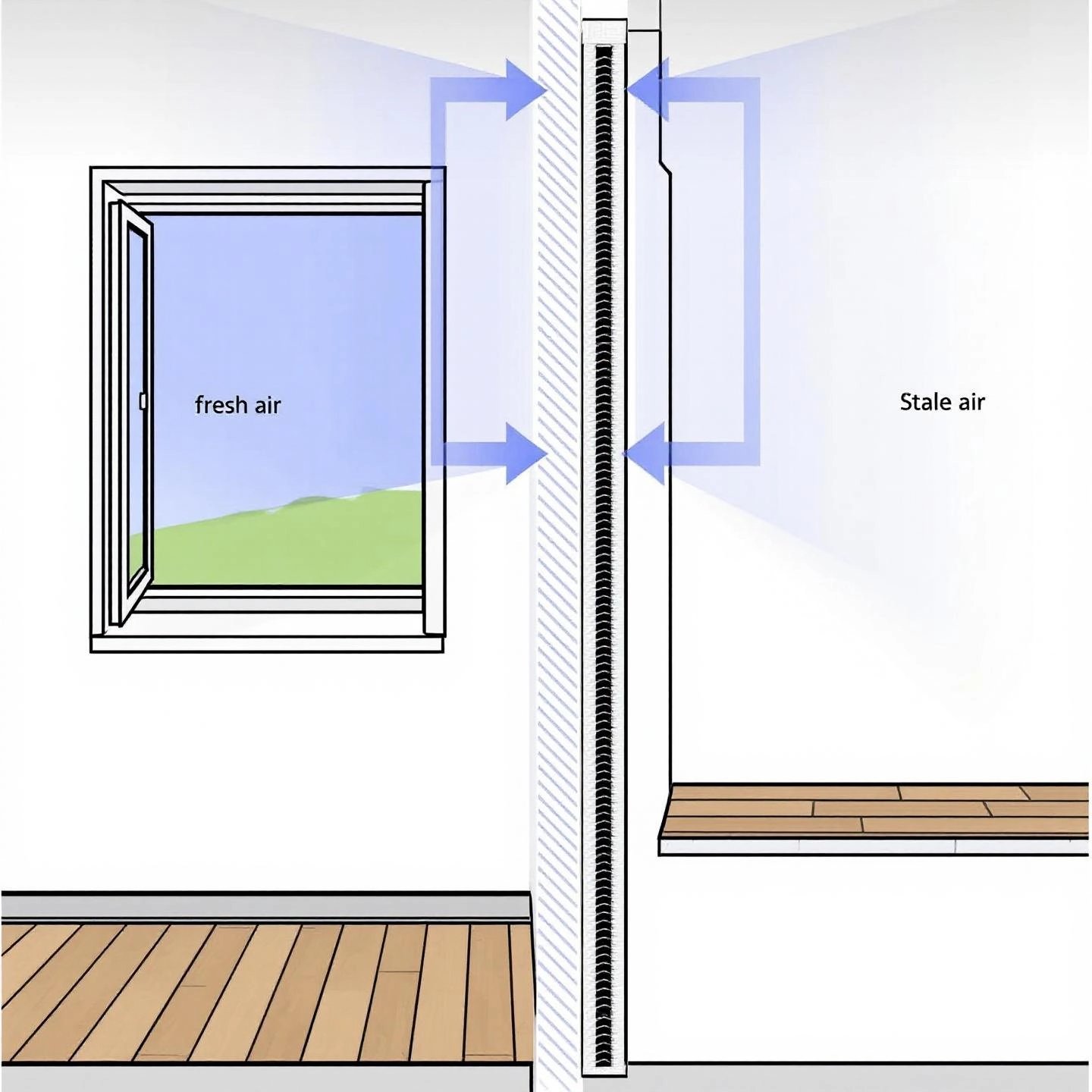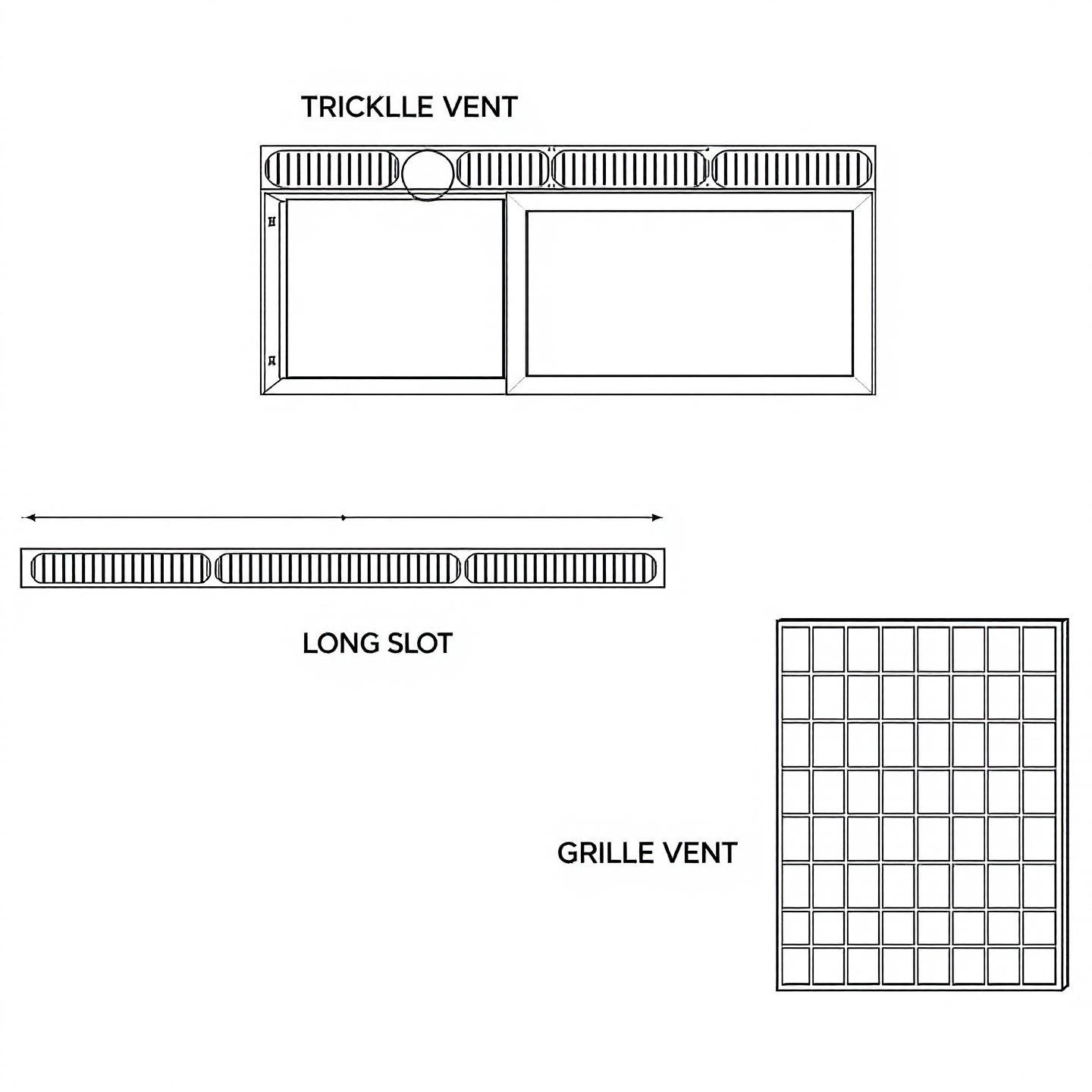
Ever walked into a room and immediately noticed it felt stuffy, humid, or had a lingering odor you just couldn’t shake? You’re not alone. Many homeowners and renters face these challenges, especially in well-sealed, energy-efficient spaces. The good news? There’s a simple yet powerful solution: the window air vent.
Window ventilation is more than just opening a window for a breeze. It’s about creating a controlled, consistent pathway for fresh air to enter and stale air to exit, without sacrificing comfort, energy efficiency, or security. Modern window air vents are designed to address everyday indoor air quality issues, including:
But how do these vents actually work? Unlike simply cracking a window, a window air vent is often integrated into the window frame or structure itself. This allows for continuous, background airflow—even when the window is closed—helping you maintain a healthy indoor environment year-round.
In this comprehensive guide, you’ll discover:
Ready to transform your indoor air quality and comfort? Let’s dive into the world of window air vents and unlock the secret to a fresher, healthier space.

Ever wondered why some rooms feel fresh and invigorating, while others seem heavy or musty? The answer often comes down to one crucial factor: fresh airflow. Proper window venting isn’t just about comfort—it’s about health, safety, and even the longevity of your home. Let’s break down why a well-chosen air ventilation window is a game-changer for your living space.
Imagine your home as a living, breathing organism. Just as our lungs need to exchange stale air for oxygen-rich air, our living spaces require a constant supply of fresh outdoor air to dilute pollutants, moisture, and odors. According to the American Lung Association, outdoor air typically contains two to five times fewer pollutants than indoor air. Without adequate ventilation, things like volatile organic compounds (VOCs), dust, carbon monoxide, and excess humidity can quickly build up indoors, creating an unhealthy environment (source).
Window air vents provide a simple, effective way to keep air moving. By allowing a steady stream of outside air to enter and indoor air to exit, they help maintain a safe and comfortable atmosphere year-round. This is especially true in modern, energy-efficient homes where airtight construction can trap pollutants and moisture inside.
So, what exactly does effective window ventilation do for you? Here are the top benefits you’ll notice when you prioritize airflow in your home:
Making the most of your air ventilation window is all about consistency and strategy. Try opening multiple windows for cross-ventilation, or use adjustable vents to control airflow without sacrificing security or comfort. In high-moisture areas, like kitchens or bathrooms, pairing window vents with exhaust fans can further reduce humidity and odors.
Of course, there are times—such as during poor outdoor air quality days or in noisy areas—when opening windows may not be ideal. In these cases, specialized window vents or trickle vents can offer continuous, controlled ventilation even when windows are closed.
Understanding the science and benefits of window venting sets the stage for choosing the right solution for your space. Next, we’ll explore the most common types of residential window vents and how they compare—so you can make an informed decision for your home’s unique needs.

When you’re deciding how best to keep your home fresh, where do you even start? With so many ventilation options out there, it’s easy to feel overwhelmed. Should you choose a classic weep hole, a modern window trickle vent, or something else entirely? Let’s break down the most popular residential window vent types—so you can match the right solution to your needs and space.
| Vent Type | Description | Ideal Use Case | Key Features |
|---|---|---|---|
| Weep Hole Vents | Small drainage holes at the base of window frames, designed to let moisture escape and prevent water buildup inside the frame. | Essential for all window types, especially in areas with frequent rain or condensation issues. |
|
| Manual Slot Vents | Adjustable vents installed as slots in the window frame, opened or closed by hand to control airflow. | Useful for homeowners who want flexible, on-demand ventilation without opening the entire window. |
|
| Window Trickle Vents | Small, integrated vents (often at the top of the frame) that allow a controlled, continuous flow of fresh air—even when the window is closed. | Perfect for modern, airtight homes and spaces prone to condensation, like kitchens and bathrooms. |
|
| Grille Vents | Fixed or adjustable grilles fitted into the window or wall, allowing free air movement between indoors and outdoors. | Best for rooms that need robust airflow or where aesthetics are less of a concern (e.g., utility rooms, basements). |
|
Imagine wanting to keep your windows shut for security, but still needing fresh air to avoid stuffiness and condensation. That’s where the window trickle vent shines. These vents offer background ventilation—meaning, they’re always working quietly in the background, ensuring a steady stream of fresh air without you having to think about it. They’re now required by building regulations for most new and replacement windows, thanks to their proven ability to improve indoor air quality and reduce moisture problems.
What makes trickle vents even more appealing is their flexibility. You can open or close them as needed, and modern designs are slim and color-matched, making them nearly invisible in your window frame. They’re especially valuable in well-insulated homes, where traditional airflow is limited by tight seals.
When considering a window vent insert or trickle vent, material choice is key. While uPVC and timber options are common, premium aluminum trickle vents offer distinct advantages that set them apart:
If you’re looking for a reliable, high-quality solution, products like Shengxin’s Window Trickle Vents combine the best of function and form. With features like easy manual sliders, robust weather resistance, and compliance with international standards, they’re a smart choice for homeowners who want peace of mind and lasting performance.
Choosing the right vent type comes down to your home’s needs, your comfort preferences, and the level of control you want over your indoor environment. As you explore options, keep in mind that a well-chosen window vent insert or trickle vent can make a world of difference—especially when it comes to balancing airflow, energy savings, and security.
Up next, we’ll look at the difference between passive and active window ventilation systems, and how to know when it’s time to upgrade for even better air quality.
When you think about letting fresh air into your home, do you picture simply opening a window, or do you imagine a dedicated system working in the background? The difference between passive window vents and active window ventilator systems can be the key to solving persistent air quality challenges—especially in large, busy, or high-moisture spaces.
Let’s break it down with a relatable scenario. Imagine you live in a compact apartment and want to keep things simple. Passive window vents—like trickle vents or integrated slot vents—rely on natural air movement. They draw in fresh air and let stale air out using wind pressure and temperature differences. No moving parts, no electricity—just the natural flow of air doing its job.
But what if you’re dealing with a sprawling home, a busy kitchen, or a gym that always feels humid and stuffy? That’s where active window ventilators come in. These systems use built-in fans and smart controls to pull in fresh air and expel stale air, regardless of outdoor conditions. Some even feature sensors to detect humidity or pollutants, automatically adjusting airflow for optimal comfort and health.
| Type | How It Works | Best For | Key Benefits |
|---|---|---|---|
| Passive Window Vents | Use natural forces (wind, temperature) to move air through fixed or adjustable vents. | Smaller rooms, mild climates, or where energy savings are a priority. |
|
| Active Window Ventilator Systems | Employ fans and smart controls to regulate airflow, sometimes with filtration and heat recovery. | Larger homes, high-moisture areas, or spaces with strict air quality needs. |
|
A window ventilation system is an integrated setup—often built into the window frame—that automatically manages air exchange. In its most advanced form, it uses fans, filters, and sometimes heat exchangers to provide a steady supply of fresh, filtered, and even temperature-controlled air. These systems can be programmed or respond to sensor data, ensuring your indoor air remains healthy without constant manual adjustment.
For example, a smart window ventilator can sense when humidity rises after a shower and automatically boost airflow to prevent mold. Or it can filter out pollen and dust—ideal for allergy sufferers—while keeping windows closed for sound insulation and security.
Wondering if an active system is right for you? Here are scenarios where a powered window ventilator makes a big difference:
Key takeaway: Passive window vents are simple, effective, and economical for many homes. But if you need precise control, advanced filtration, or consistent ventilation in challenging conditions, an active window ventilation system is your best ally.
Ready to explore hands-on solutions for renters and DIYers? Next, we’ll look at easy-install window vent inserts and kits designed for flexible, non-permanent use—so you can enjoy better air without a major renovation.
Ever wanted better airflow but worried about drilling holes or making permanent changes to your home or apartment? You’re not alone. For renters, DIY enthusiasts, or anyone needing a quick fix, window vent inserts and window vent kits are a game-changer. But what exactly are these solutions, and how do they work?
Imagine you could add ventilation to almost any window—without special tools, construction, or long-term commitment. That’s the promise of window vent inserts and kits. These products are designed to fit snugly into your existing window opening, providing a pathway for fresh air or exhaust, all while being easy to install and remove.
Sounds complex? It’s actually the opposite. These solutions are designed for everyday convenience and versatility. Here’s why they’re so popular:
Worried about the process? Here’s a quick step-by-step overview that shows just how simple it can be:
That’s it! Most installations take less than 15 minutes and require no tools or special skills. Even better, you can remove the insert or kit at any time—no trace left behind.
In summary, if you’re looking for a flexible, non-permanent way to boost airflow, a window vent insert or kit is a smart, user-friendly solution. Next, we’ll explore how window exhaust vents take air quality a step further by actively removing stale air and odors from your space.

Ever cooked a big meal and noticed the kitchen still smells like last night’s dinner hours later? Or maybe your home gym feels stuffy after a workout, even with the windows cracked open. If you’ve faced these challenges, installing a window exhaust vent might be your next best move for fresher, cleaner air.
Unlike passive intake vents—which let outside air in—a window exhaust vent is designed to actively remove stale, humid, or odorous air from inside your space. The result? A noticeable improvement in air quality, comfort, and even building health. You’ll quickly notice the difference in rooms that are prone to lingering smells, excess moisture, or heat buildup.
It’s easy to confuse the two, but their roles are distinct:
| Feature | Passive Intake Vent | Window Exhaust Vent |
|---|---|---|
| Main Function | Allows fresh outside air in | Expels indoor air outside |
| Typical Use | Living rooms, bedrooms (background ventilation) | Kitchens, bathrooms, gyms, workshops (targeted exhaust) |
| Operation | Relies on natural airflow (wind, pressure) | Often uses a fan or mechanical system for active removal |
| Best For | General air renewal | Odor, humidity, or pollutant removal |
While passive vents are excellent for maintaining a baseline of fresh air, they may not be enough in high-moisture or high-odor areas. That’s where a dedicated window exhaust vent comes in—actively drawing out unwanted air for faster, more effective results.
Imagine turning a standard window into a powerful exhaust point—without major renovations. That’s exactly what a window exhaust kit is designed to do. These kits typically include:
Here’s how it works in practice:
Some kits even allow for dual hoses—one for intake and one for exhaust—giving you maximum control over air movement and efficiency.
In summary, a window exhaust vent or kit turns your window into an efficient exit point for stale air—making kitchens, gyms, and workshops instantly fresher and more comfortable. Next, we’ll shift gears and look at how specialized window vents keep your car or pet safe and cool, even on the hottest days.

Ever left your car parked on a sunny day, only to return to a cabin that feels like an oven? Or worried about your pet’s comfort and safety during road trips? If you’ve found yourself cracking the windows and hoping for the best, you’re not alone. The right car window vent offers a practical, reliable solution for both comfort and safety—whether you’re driving, parked, or traveling with family and pets.
Let’s break it down: modern vehicles are designed to be airtight for efficiency, but that also means heat and stale air can build up quickly—especially in warm weather or when pets are along for the ride. A car window air vent helps maintain a steady flow of fresh air, even when the windows are only partially open. This small addition can make a big difference in several everyday scenarios.
Not all car window vents are created equal. Depending on your needs, you’ll find a range of options—from simple, affordable guards to robust, custom-fit kits:
Imagine you’re driving cross-country with your dog. With a custom window screen in place, you can roll down the windows for a cross breeze, keeping your pet cool and happy—without worrying about safety. Or, picture a rainy commute: vent visors let you crack the windows for fresh air, staying dry while reducing fog and stuffiness inside the cabin.
Key takeaway: Whether you’re concerned about pet safety, family comfort, or simply want a more pleasant driving experience, a car window vent is a smart, user-friendly upgrade for any vehicle.
Ready to choose the best vent for your needs? Next, we’ll provide a practical checklist to help you select the right window air vent—whether for your home, car, or anywhere you need fresh, healthy airflow.
When it comes time to select a window air vent, the choices can feel overwhelming. Do you need a simple adjustable window vent for a bedroom, or a robust aluminum window vent for a high-moisture kitchen? Let’s break down the decision-making process with a practical, step-by-step checklist—so you can find the perfect solution for your space, comfort, and budget.
Imagine you’re standing in front of a display of vents at your local store or browsing options online. How do you know which one is right for you? Start by asking yourself these questions:
| Consideration | Why It Matters | Tips & Examples |
|---|---|---|
| Your Ventilation Goals | Are you looking to combat condensation, prevent mold, reduce odors, or simply improve everyday comfort? |
|
| Location of Installation | Where you place your vent affects its performance and longevity. |
|
| Passive vs. Active Solutions | Do you need continuous background ventilation or active, powered airflow? |
|
| Budget | Costs can vary widely based on features, materials, and brand. |
|
| Material & Aesthetic Preferences | The right material ensures longevity and matches your décor. |
|
Still unsure about which material to choose? Consider the advantages of a premium aluminum window vent. Unlike basic plastic alternatives, aluminum vents—such as Shengxin’s Window Trickle Vents—are engineered for long-term performance. They resist corrosion, withstand frequent use, and maintain their appearance over time. Plus, their slim, unobtrusive design blends seamlessly with modern window frames, and their manual slider lets you easily control airflow as your needs change.
Shengxin’s vents, in particular, are manufactured under ISO 9001:2015 standards and are RoHS compliant, ensuring both safety and quality. They’re a smart investment for homeowners who want a solution that not only performs but also protects their home from condensation and mold—without sacrificing energy efficiency or security.
By following this checklist, you’ll be well-equipped to select a window air vent that truly meets your needs—whether you’re upgrading a single room or your entire home. And if you’re seeking a durable, energy-efficient solution that stands the test of time, premium aluminum options like Shengxin’s Window Trickle Vents are a top choice.
Once you’ve chosen the right vent, proper care is key. Up next, we’ll cover simple maintenance tips to keep your window vents working efficiently for years to come.
When was the last time you gave your window vents a little attention? If you’re like most homeowners, it’s easy to overlook these silent workhorses—until you notice reduced airflow, stubborn odors, or even condensation creeping back in. The good news? Regular window vent maintenance is straightforward, and just a few simple steps can keep your vents working efficiently for years to come.
Imagine you’re prepping your home for a new season or just want to breathe a little easier. Here’s a practical, step-by-step guide to caring for your window vents—no special tools or expertise required:
By making window vent maintenance part of your regular routine, you’ll enjoy fresher air, better energy efficiency, and fewer costly repairs. Next up: we’ll wrap up with a summary of why fresh air matters and how the right window air vent can transform your indoor environment for good.
Ever wonder why some spaces feel instantly refreshing, while others seem to trap every bit of humidity, odor, or stuffiness? The answer often comes down to one overlooked detail: effective ventilation. Whether you’re upgrading a family home, renting an apartment, or making your car safer for pets and passengers, choosing the best window air vent can transform your environment from stale to invigorating—without complicated renovations or hefty bills.
Imagine coming home after a long day to a living room that feels light, smells clean, and simply lets you breathe easier. That’s the everyday benefit of proper window ventilation. By allowing a steady, controlled exchange of air, a window air vent helps:
And the best part? There’s a window ventilation solution for just about every scenario. From slim, unobtrusive trickle vents in your bedroom, to robust car window air vents for on-the-go comfort, the options are as versatile as your needs.
Throughout this guide, we’ve explored how window air vents tackle common challenges in all types of spaces:
No matter your situation, there’s a window air vent designed to make fresh air effortless.
Ready to make a change? Start by assessing your unique ventilation needs—consider the rooms or vehicles where air feels stagnant, where condensation is a problem, or where odors linger. Then, choose a solution that fits your lifestyle and space.
For those seeking a reliable, long-term answer, premium options like Shengxin’s Window Trickle Vents stand out. Engineered for durability, ease of use, and seamless integration, they offer precisely controlled, passive airflow that helps improve indoor air quality every day. With quality manufacturing standards and a slim, unobtrusive design, Shengxin’s vents are a smart investment in your home’s comfort, health, and energy efficiency.
In summary: Fresh air isn’t a luxury—it’s essential. And with the right window air vent, achieving it is simpler than ever. Take a moment to evaluate your space, consider your needs, and choose a solution that brings lasting benefits. Your lungs, your family, and even your wallet will thank you.
A window air vent is a device integrated into or added onto a window frame to allow controlled airflow between indoors and outdoors. It promotes consistent ventilation by letting fresh air in and stale air out, even when the window is closed. This helps reduce stuffiness, condensation, and odors, supporting a healthier indoor environment.
Yes, window trickle vents are especially important in modern, well-sealed homes where natural airflow is limited. They provide background ventilation, preventing issues like condensation and mold without compromising energy efficiency or security. Many building regulations now require their use in new or replacement windows.
To select the best window air vent, consider your ventilation goals (like humidity control or odor removal), installation location, whether you prefer passive or active airflow, your budget, and desired material. High-grade aluminum options, such as Shengxin’s Window Trickle Vents, offer durability, easy operation, and a discreet look, making them a strong choice for most homes.
Absolutely. Window vent inserts and kits are designed for easy, non-permanent installation. They require no drilling or lasting modifications, making them ideal for renters and anyone seeking a flexible, tool-free solution to improve airflow.
Window air vents need regular inspection and cleaning to ensure optimal performance. This includes removing dust and debris, checking for blockages or mold, cleaning vent covers, and ensuring seals and moving parts work smoothly. For powered vents, replace filters as recommended by the manufacturer.
 บริการออนไลน์
บริการออนไลน์ 0086 136 3563 2360
0086 136 3563 2360 sales@sxalu.com
sales@sxalu.com +86 136 3563 2360
+86 136 3563 2360